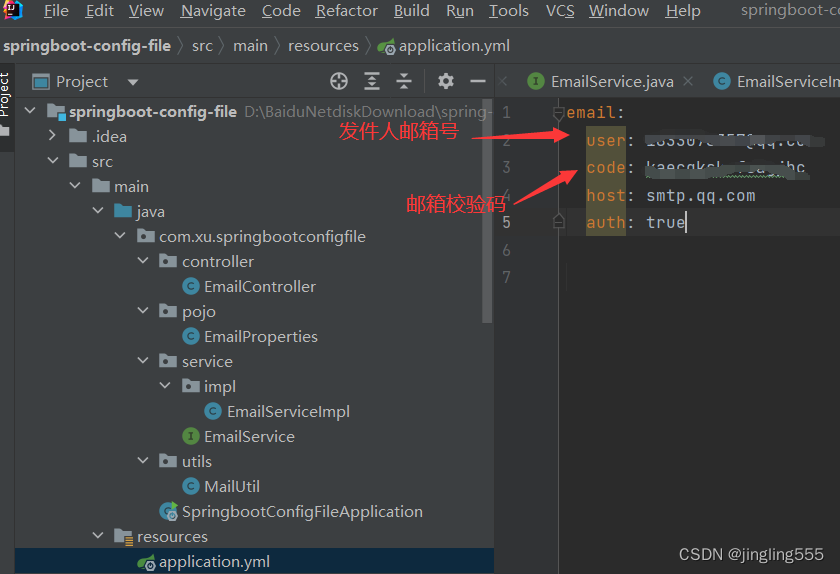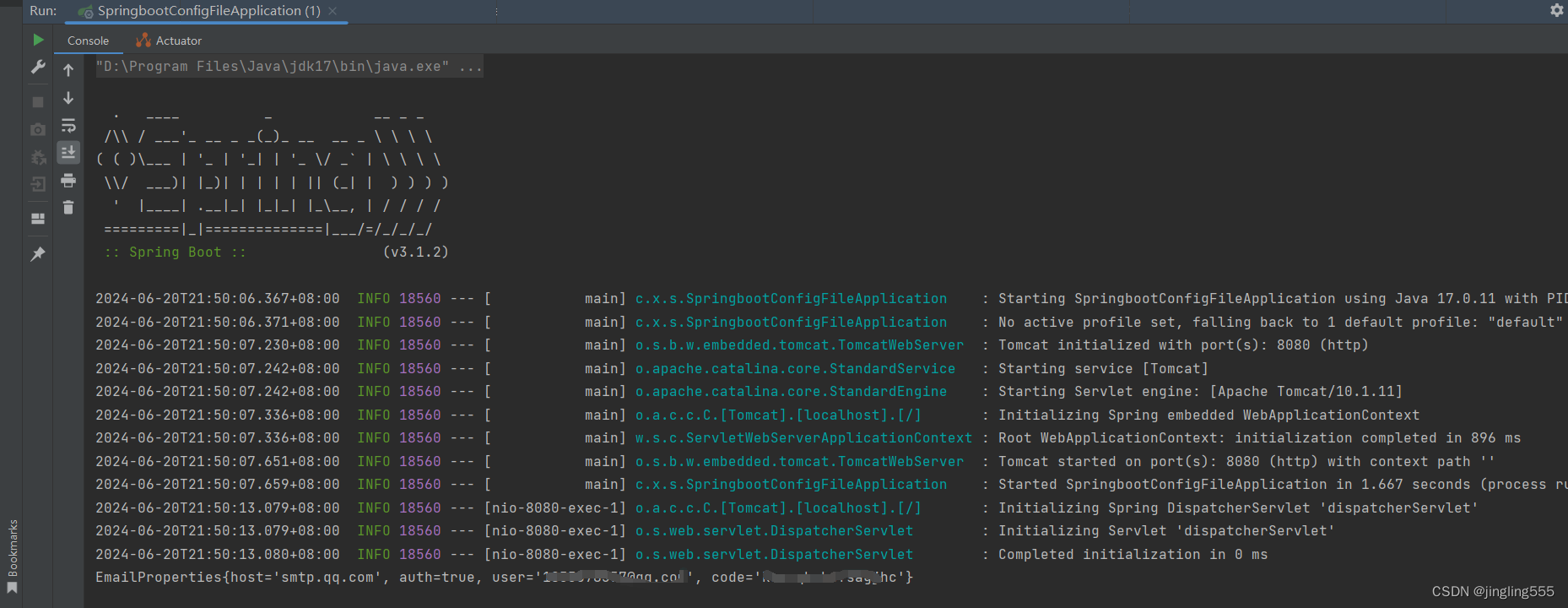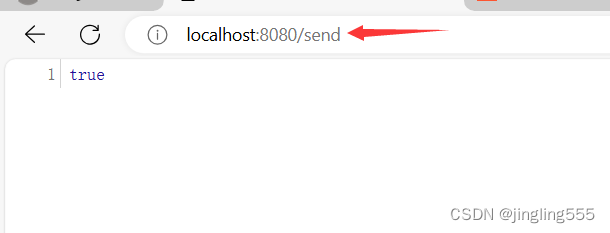运行环境:
- IntelliJ IDEA 2022.2.5 (Ultimate Edition) (注意:idea必须在2021版本以上)
- JDK17
项目目录:

该项目分为pojo,service,controller,utils四个部分,
在pojo层里面写实体内容(发邮件需要的发件人邮箱,授权码,服务器域名,身份验证开关),
service层里面写send方法,
utils里面写发送邮件实现的工具类,
controller层里面调用service里面的方法测试send方法。
在resource里面的application.yml写相关的发邮件参数(user,code,host,auth)
前提:
该项目涉及到了邮件的发送,所以需要邮箱的授权码
怎么获取授权码?
在 账号与安全 --安全设置--SMTP/IMAP服务 中开启服务并获取授权码
代码:
pojo层:
package com.xu.springbootconfigfile.pojo;
import org.springframework.beans.factory.annotation.Value;
import org.springframework.boot.context.properties.ConfigurationProperties;
import org.springframework.stereotype.Component;
@Component
@ConfigurationProperties(prefix = "email")
public class EmailProperties {
//@Value("${email.user}")
//发件人邮箱
public String user ;
//@Value("${email.code}")
//发件人邮箱授权码
public String code ;
//@Value("${email.host}")
//发件人邮箱对应的服务器域名,如果是163邮箱:smtp.163.com qq邮箱: smtp.qq.com
public String host ;
//@Value("${email.auth}")
//身份验证开关
private boolean auth ;
public String getHost() {
return host;
}
public void setHost(String host) {
this.host = host;
}
public boolean isAuth() {
return auth;
}
public void setAuth(boolean auth) {
this.auth = auth;
}
public String getUser() {
return user;
}
public void setUser(String user) {
this.user = user;
}
public String getCode() {
return code;
}
public void setCode(String code) {
this.code = code;
}
@Override
public String toString() {
return "EmailProperties{" +
"host='" + host + '\'' +
", auth=" + auth +
", user='" + user + '\'' +
", code='" + code + '\'' +
'}';
}
}
service层:
package com.xu.springbootconfigfile.service;
public interface EmailService {
boolean send(String to,String title,String content);
}
package com.xu.springbootconfigfile.service.impl;
import com.xu.springbootconfigfile.pojo.EmailProperties;
import com.xu.springbootconfigfile.service.EmailService;
import com.xu.springbootconfigfile.utils.MailUtil;
import org.springframework.beans.factory.annotation.Autowired;
import org.springframework.stereotype.Service;
@Service
public class EmailServiceImpl implements EmailService {
//注入email配置信息实体类
@Autowired
private EmailProperties emailProperties;
/**
* @param to 收件人邮箱
* @param title 邮件标题
* @param content 邮件正文
* @return
*/
@Override
public boolean send(String to, String title, String content) {
//打印email配置信息
System.out.println(emailProperties);
//发送邮件
boolean flag = MailUtil.sendMail(emailProperties,to, title, content);
return flag;
}
}
controller层:
package com.xu.springbootconfigfile.controller;
import com.xu.springbootconfigfile.service.EmailService;
import org.springframework.beans.factory.annotation.Autowired;
import org.springframework.web.bind.annotation.RequestMapping;
import org.springframework.web.bind.annotation.RestController;
@RestController
public class EmailController {
//注入email配置信息实体类
@Autowired
private EmailService emailService;
//测试方法
@RequestMapping("/send")
public Boolean send(){
//收件人信箱
String to = "邮箱号";
//邮件标题
String title = "test";
//邮件正文
String content = "哈哈哈哈哈哈哈";
//发送邮件
boolean flag = emailService.send(to,title,content);
return flag;
}
}
utils层:
package com.xu.springbootconfigfile.utils;
import com.xu.springbootconfigfile.pojo.EmailProperties;
import jakarta.mail.*;
import jakarta.mail.internet.InternetAddress;
import jakarta.mail.internet.MimeMessage;
import java.util.Properties;
public class MailUtil {
/**
* 发送邮件
* @param emailProperties 发件人信息(发件人邮箱,发件人授权码)及邮件服务器信息(邮件服务器域名,身份验证开关)
* @param to 收件人邮箱
* @param title 邮件标题
* @param content 邮件正文
* @return
*/
public static boolean sendMail(EmailProperties emailProperties, String to, String title, String content){
MimeMessage message = null;
try {
Properties properties = new Properties();
properties.put("mail.smtp.host", emailProperties.getHost());
properties.put("mail.smtp.auth",emailProperties.isAuth());
properties.put("mail.user", emailProperties.getUser());
properties.put("mail.password", emailProperties.getCode());
// 构建授权信息,用于进行SMTP进行身份验证
Authenticator authenticator = new Authenticator() {
@Override
protected PasswordAuthentication getPasswordAuthentication() {
return new PasswordAuthentication(emailProperties.getUser(), emailProperties.getCode());
}
};
// 使用环境属性和授权信息,创建邮件会话
Session mailSession = Session.getInstance(properties, authenticator);
// 创建邮件消息
message = new MimeMessage(mailSession);
}catch (Exception e){
e.printStackTrace();
}
//如果邮件创建失败,直接返回
if (message==null){
return false;
}
try {
// 设置发件人
InternetAddress form = new InternetAddress(emailProperties.getUser());
message.setFrom(form);
// 设置收件人
InternetAddress toAddress = new InternetAddress(to);
message.setRecipient(Message.RecipientType.TO, toAddress);
// 设置邮件标题
message.setSubject(title);
// 设置邮件的内容体
message.setContent(content, "text/html;charset=UTF-8");
// 发送邮件
Transport.send(message);
}catch (Exception e){
e.printStackTrace();
}
return true;
}
}
application.yml

pom.xml文件:
<?xml version="1.0" encoding="UTF-8"?>
<project xmlns="http://maven.apache.org/POM/4.0.0" xmlns:xsi="http://www.w3.org/2001/XMLSchema-instance"
xsi:schemaLocation="http://maven.apache.org/POM/4.0.0 https://maven.apache.org/xsd/maven-4.0.0.xsd">
<modelVersion>4.0.0</modelVersion>
<parent>
<groupId>org.springframework.boot</groupId>
<artifactId>spring-boot-starter-parent</artifactId>
<version>3.1.2</version>
<relativePath/> <!-- lookup parent from repository -->
</parent>
<groupId>com.xu</groupId>
<artifactId>springboot-config-file</artifactId>
<version>0.0.1-SNAPSHOT</version>
<name>springboot-config-file</name>
<description>springboot-config-file</description>
<properties>
<java.version>17</java.version>
</properties>
<dependencies>
<!--web开发依赖-->
<dependency>
<groupId>org.springframework.boot</groupId>
<artifactId>spring-boot-starter-web</artifactId>
</dependency>
<!--java mail 依赖-->
<dependency>
<groupId>org.eclipse.angus</groupId>
<artifactId>jakarta.mail</artifactId>
</dependency>
</dependencies>
<build>
<plugins>
<plugin>
<groupId>org.springframework.boot</groupId>
<artifactId>spring-boot-maven-plugin</artifactId>
</plugin>
</plugins>
</build>
</project>
运行结果:


显示true后,检查一下邮箱,就可以收到对应的测试邮件






















 2万+
2万+











 被折叠的 条评论
为什么被折叠?
被折叠的 条评论
为什么被折叠?








